Key takeaways:
- Community leadership requires fostering relationships, embracing diverse perspectives, and creating spaces for genuine dialogue within the community.
- Access to stable housing is crucial for community well-being and economic development, as it enables individuals to invest in their skills and contribute to society.
- Effective leadership involves open communication, setting clear goals, and celebrating small wins, which helps in building trust and motivation among community members.
- Understanding and addressing community challenges through empathy and collaboration can transform obstacles into opportunities while fostering resilience and solidarity.
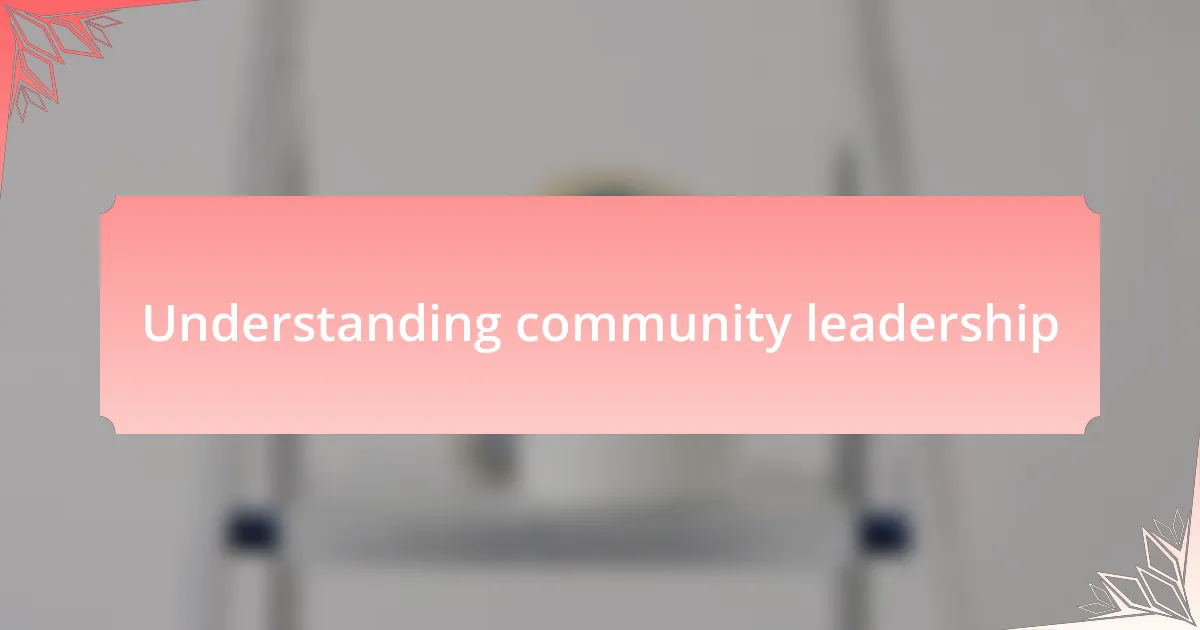
Understanding community leadership
Community leadership is about more than just holding a title; it’s a commitment to fostering relationships and encouraging participation within the community. I remember a time when I attended a local meeting where a few passionate individuals came together to discuss housing issues. Their energy was contagious, and it struck me how genuine conversation could spark action—what if every community had a space for just such dialogue?
Understanding community leadership also requires recognizing the unique dynamics that exist within different groups. I once volunteered with a youth organization where I witnessed how powerful it is when young voices are included in decision-making. It made me reflect: how often do we overlook the insights of those who are closest to the challenges? True leadership embraces all perspectives, and that diversity can lead to more effective solutions.
Moreover, effective community leadership demands vulnerability and authenticity. In my experience, sharing my own struggles with housing accessibility allowed others to feel safe in sharing theirs too. Have you ever considered how shared experiences can unite us? This connection not only builds trust but also transforms individual stories into collective movements, reminding us of the strength that lies in unity.
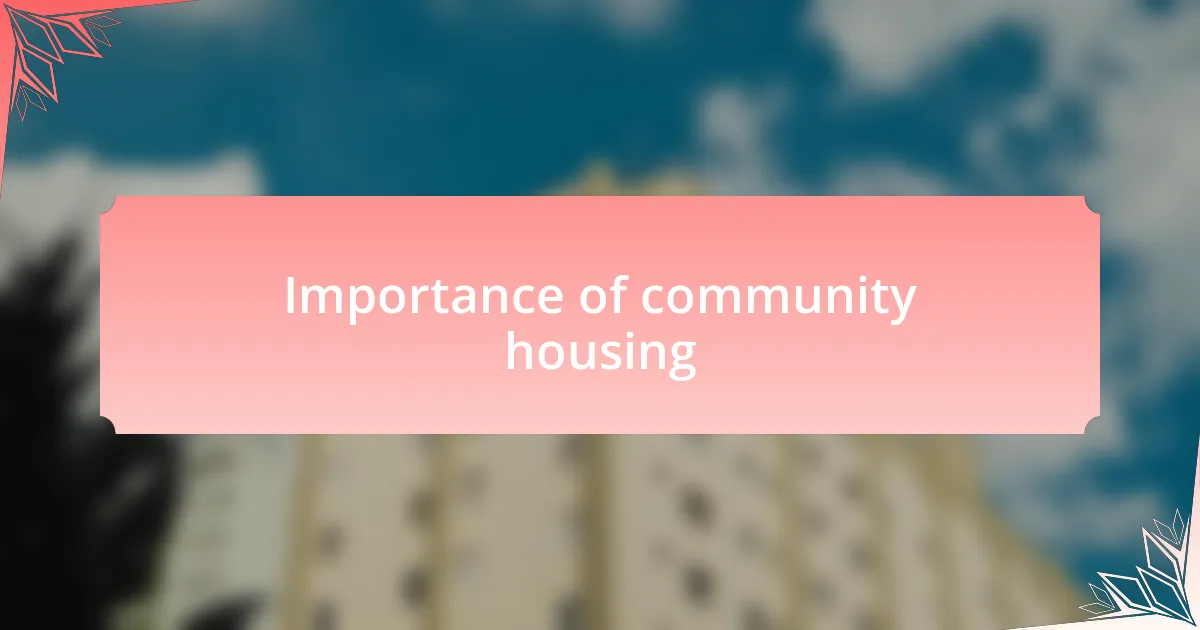
Importance of community housing
Housing isn’t just a roof over our heads; it’s a fundamental right that shapes our communities. I recall a neighborhood block party where families shared food and stories about their homes. It struck me how these connections deepened our sense of belonging. When everyone has access to stable housing, the whole community thrives, fostering cooperation and social cohesion that can drive meaningful change.
Furthermore, community housing serves as a catalyst for economic development. One weekend, I participated in a local clean-up initiative, and I noticed how many residents began discussing potential local businesses that could benefit from a stronger, supportive housing landscape. Have you ever thought about how a stable living environment empowers individuals to invest in their skills and contribute to their neighborhoods? This creates a vibrant ecosystem where everyone can flourish.
In my experience, well-planned community housing can empower individuals and families, helping break cycles of poverty and instability. I once attended a workshop on affordable housing solutions where participants shared their success stories—how access to stable housing allowed them to pursue education and careers they thought were out of reach. Isn’t it remarkable to think about how a home can change lives and uplift an entire community?
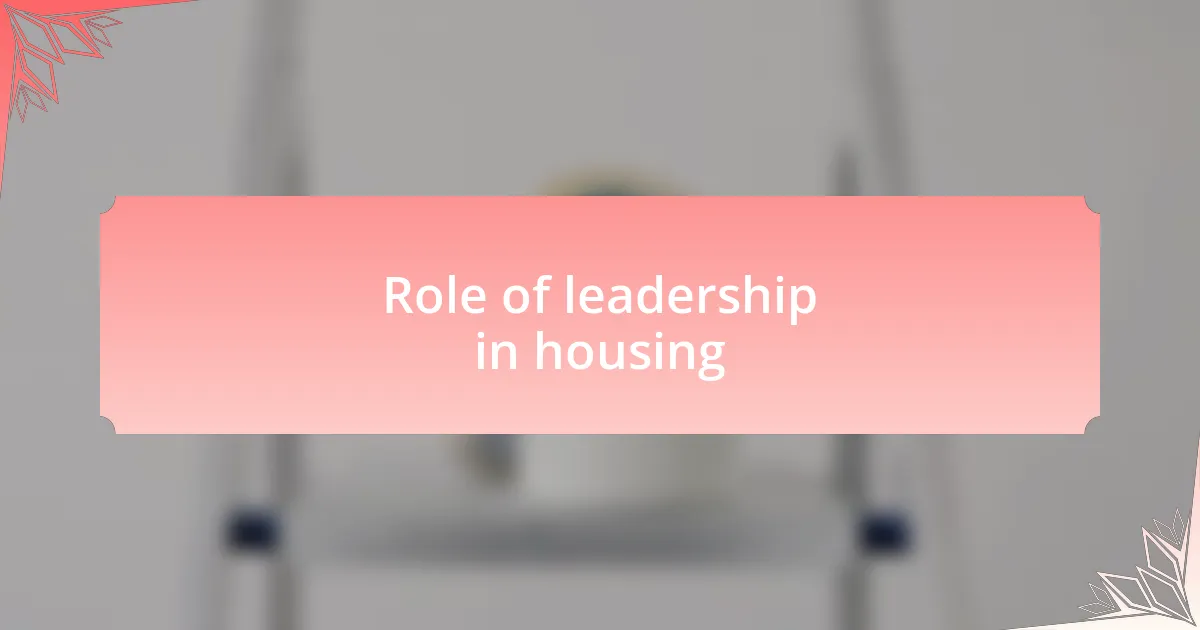
Role of leadership in housing
Leadership in the housing sector is pivotal because it sets the vision and direction for community development. Reflecting on my experience attending a town hall meeting, I was struck by how effective leaders use their influence to galvanize community members around shared housing goals. Have you ever seen how one passionate leader can inspire change? It’s often the spark that ignites community involvement and trust.
Thoughtful leadership also encompasses advocating for policies that promote affordable housing. I remember discussing zoning laws with a local leader who was fervently pushing for reforms. His passion was contagious and shed light on how such policies impact access to housing. It made me realize that without strong advocacy, marginalized groups may continue to face barriers that limit their choices.
Moreover, leaders play a crucial role in fostering partnerships between local organizations and residents. I once volunteered alongside a dedicated group trying to establish housing co-ops, and I observed how leadership facilitated connections that empowered individuals. These collaborative efforts made it clear to me that leadership isn’t just about making decisions; it’s about listening to the community and being a champion for collective needs. Isn’t that the kind of leadership we can all get behind?
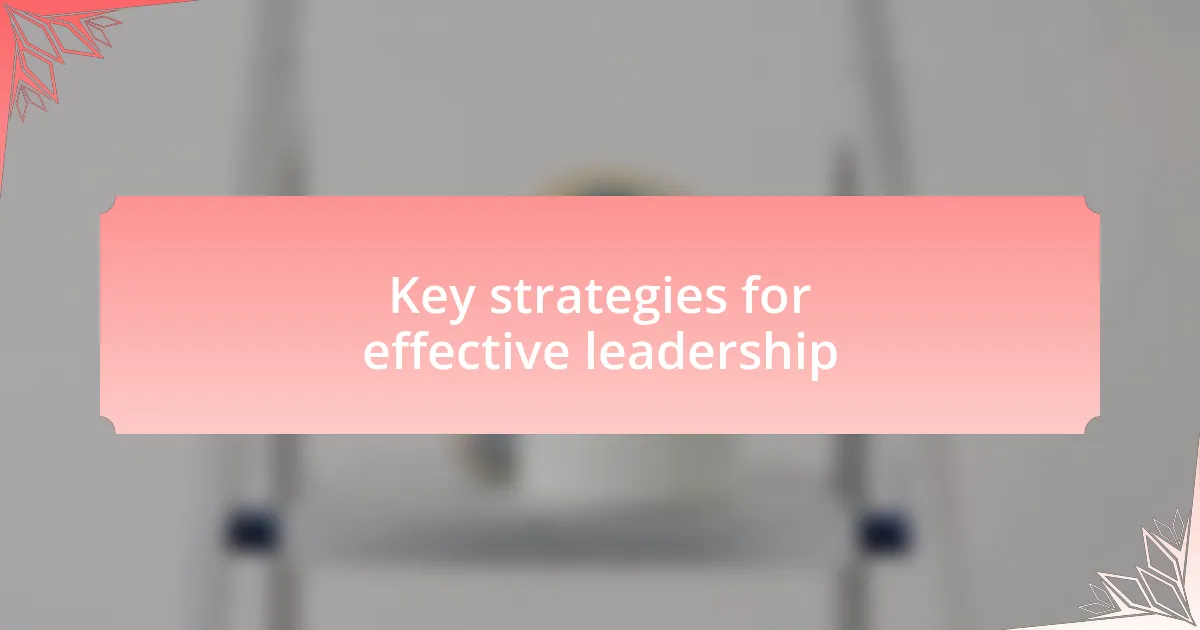
Key strategies for effective leadership
One key strategy for effective leadership in community housing development is fostering open communication. I recall a particular meeting where a leader emphasized the importance of creating a safe environment for everyone to voice their concerns. This simple act of listening made community members feel valued and encouraged them to share their thoughts openly. Have you ever felt the power of being heard? It can change the dynamic entirely and lead to better decision-making.
Another vital aspect is setting clear, achievable goals. I remember working with a team that struggled to unite around a vague vision. Once we outlined specific objectives, like increasing the number of affordable units by a certain percentage, it was like a fog lifted. Everyone could suddenly see the path forward. This approach reminded me that clarity not only motivates but also creates accountability. How can we expect progress if we don’t know what we’re aiming for?
Lastly, recognizing and celebrating small wins along the way can keep morale high. During a community development project, I witnessed how acknowledging tiny milestones—like completing the first phase of a housing initiative—brought everyone together in celebration. It made me realize that leadership isn’t just about reaching the finish line; it’s also about appreciating the journey. How often do we take a moment to celebrate our progress? This simple act can renew our energy and commitment to the broader mission.
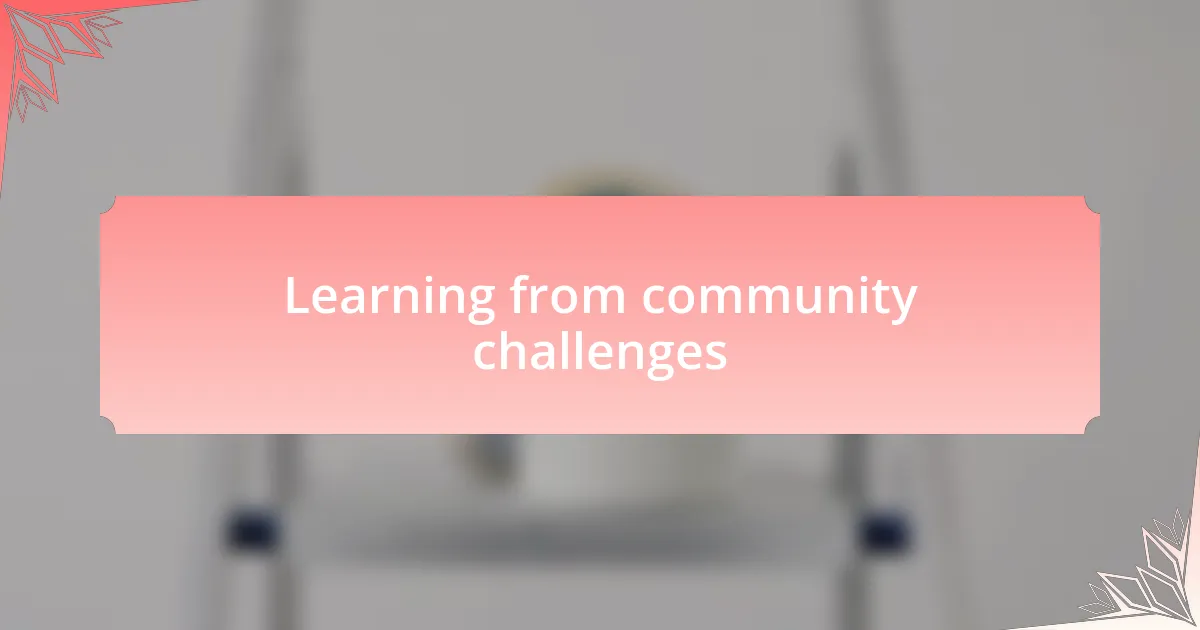
Learning from community challenges
Learning from community challenges often requires confronting uncomfortable truths. For instance, I participated in a neighborhood clean-up where, despite our efforts, we faced resistance from residents who didn’t see the value in the work we were doing. Listening to their concerns opened my eyes; it was a vital lesson in understanding that without addressing the community’s underlying frustrations, even the best intentions can fall flat. Have you ever found yourself questioning the effectiveness of your contributions? It made me realize that genuine engagement starts with empathy.
Sometimes, challenges expose gaps in resources or support that must be acknowledged. I remember tackling a housing project that stalled due to a lack of funding and resources. Instead of pushing ahead blindly, our team held open forums to explore alternative solutions. This led to unexpected partnerships with local businesses willing to donate materials. It highlighted a profound lesson: collaboration can turn obstacles into opportunities. How often do we overlook the potential allies in our own community?
The learning doesn’t just come from the challenges themselves but also from the resilience they inspire. I’ll never forget the day a severe storm damaged part of our community housing project. Instead of despairing, residents rallied together to help one another, showcasing an incredible spirit of solidarity. In that moment, I learned that adversity can bring out the best in people, transforming challenges into unifying experiences. Have you ever witnessed a community come together in the face of hardship? It’s a powerful reminder that we can emerge stronger when we face difficulties together.
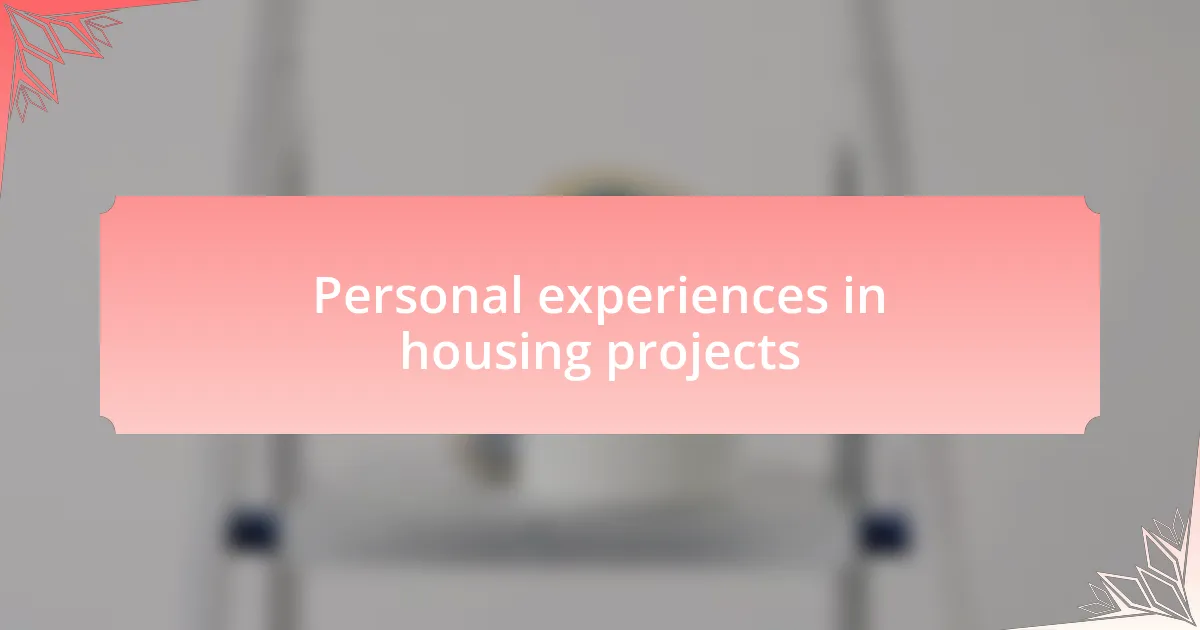
Personal experiences in housing projects
In my journey through various housing projects, I witnessed firsthand how community involvement can profoundly shape outcomes. During one initiative, we organized a series of workshops where residents could voice their needs and ideas. I was truly surprised by the wealth of knowledge they shared, revealing not only their vision for the project but also their hope for a brighter future. Have you ever felt inspired by the simple act of sharing stories? In that space, we transformed a disconnected group into a cohesive team, united by a common purpose.
Another memorable experience involved a housing project where we aimed to incorporate green spaces. I vividly recall the discussions that turned contentious as some participants prioritized immediate housing needs over aesthetics. However, during one meeting, a grandfather spoke about how green areas could benefit his grandchildren’s mental health. That perspective shifted the conversation entirely. It made me appreciate how personal narratives can influence decision-making. How often do we consider the broader impact of our choices on future generations?
Then there was a project that had the potential to create affordable housing but faced significant opposition from a neighboring community. Rather than dismissing their concerns, we initiated dialogue sessions that allowed us to address fears directly. What astonished me was how transparency and open communication turned skepticism into support. As I stood there, watching former opponents become advocates for the project, I realized that understanding and respect can bridge even the widest gaps. Isn’t it fascinating how dialogue can transform conflict into collaboration?
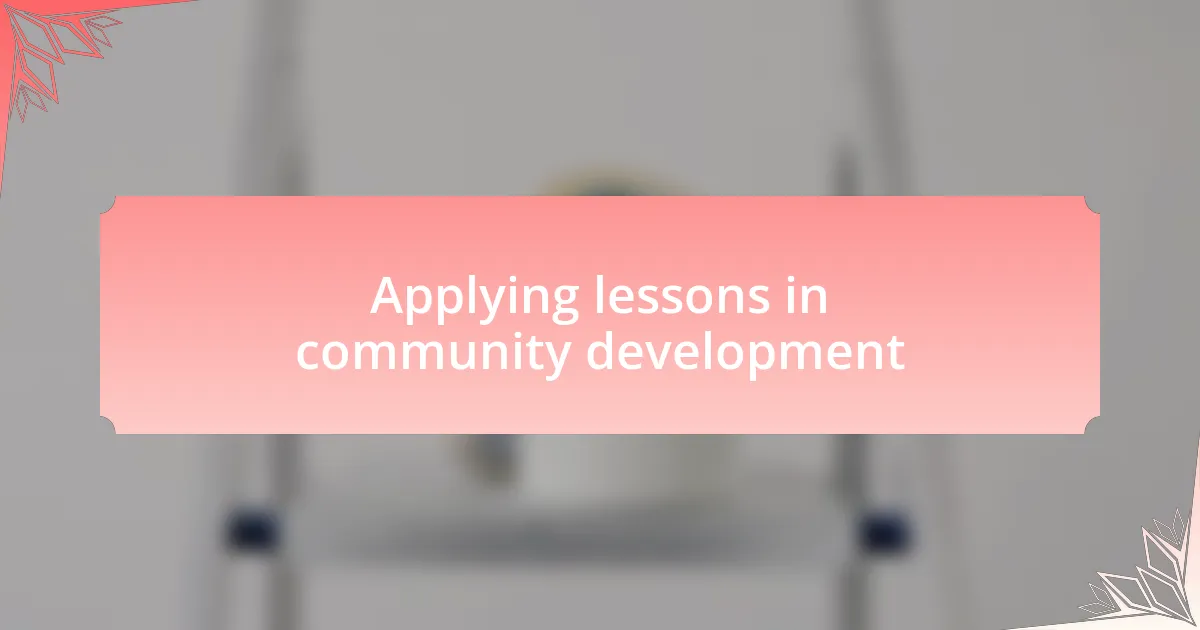
Applying lessons in community development
When it comes to applying lessons in community development, I’ve learned the invaluable importance of active listening. In one particular initiative, we invited community members to share their thoughts and feedback on proposed design plans. I remember one participant, a local artist, illustrating how vibrant murals could enhance the neighborhood’s identity. That moment struck me—it wasn’t just about building houses but creating a sense of belonging. Have you ever realized that the smallest suggestions can lead to the most transformative ideas?
Another lesson I’ve embraced is the power of flexibility in decision-making. During a project aimed at revitalizing an underused park, we initially pushed for a specific layout that included a playground and picnic areas. Yet, after some community feedback, we shifted our focus to creating an open space that could accommodate various activities, like farmer’s markets and community gatherings. This experience taught me that being adaptable often leads to solutions that resonate more deeply with the community’s evolving needs. How do we balance our vision with community wishes in this ever-changing landscape?
In my journey, I’ve also come to appreciate the role of patience in fostering community trust. I recall a frustrating period when a project faced delays due to regulatory hurdles. Rather than rushing through the process, we slowed down and communicated regularly with community members about what was happening. Over time, their initial frustration transformed into patience and understanding. Isn’t it interesting how transparency can turn a challenging situation into an opportunity for deeper engagement and collaboration?